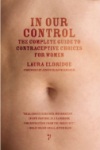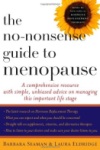Three years ago, at twenty-seven, I ended my long-term relationship with the Pill. I had used it off and on for about nine years. Things hadn’t been good for a long time, and I had been desperately looking for a way to leave, but felt trapped. It turned out the answer I’d been looking for was there all along.
I first went on the Pill when I was eighteen. I had been dating a boyfriend for almost a year and was thinking about having sex. Of course I planned to use condoms as well, but I was heading off to college in New York City in the fall and didn’t want to jeopardize my future in any way. As a good child of the 1990s, I’d sat through tons of sexual education classes. They all conveyed the same message: birth control pills were the way to go. I also knew what my friends were saying, what the girls who became sexually active before me whispered over French fries in the cafeteria of my small Utah Catholic high school. The only way to be really safe, pregnancy-wise, was to take matters into your own hands.
Being eighteen, I didn’t march up to the family doctor and ask for the Pill, although thanks to good marketing on the part of Pill makers I probably could have. I could have feigned bad periods or claimed that I wanted it to erase the blemishes that had danced further and further down my forehead towards my eyebrows as puberty progressed. But I didn’t. Instead, I did what savvy young people in the Salt Lake Valley did when they were in my situation: I went to the small Planned Parenthood, located about two blocks from the high school.
Kids went there because it was cheap, and more importantly, it employed the precious “don’t ask, don’t tell” policy. I knew girls too afraid to ask for pelvic exams who went there out of concern for basic health, and of course I knew those who went for pregnancy tests and abortions. I was pretty nervous on that desert-hot July day when I parked my beat-up red car next to the clinic and walked furtively into the small lobby, praying that none of my friends’ parents would see me. I read over a brochure that laid out the different contraceptive methods next to their respective efficacy rates as I sat and waited for my consultation, but in truth I had decided what I wanted long before I darkened the clinic doors. A kind, softspoken staff doctor gave me my first pelvic exam and wrote me a prescription for a popular tri-cyclic pill.
The first few weeks I was on the Pill, not much happened. My breasts swelled up and became painful, and I found that though I hadn’t really had PMS before, I was suddenly inconsolable for two or three days before a bleed. Otherwise, I was pretty happy.
I went off to school in the fall and dropped the Pill. I rarely saw my boyfriend, and remembering to take it was too much of a pain. I would go back on periodically over the next six or seven years, always struggling to take it regularly but never considering that otherwise unexplained changes in my health—for example, migraine headaches I had never experienced before—were due to Pill use. And I can honestly say I didn’t think much more about it.
In 1999, the way I thought about contraception changed. I had the tremendous honor of meeting and working with the great author and activist Barbara Seaman. Barbara died recently after a short battle with lung cancer and nearly fifty years of battling with drug companies, doctors, and scientists over dangerous drugs, including hormonal contraception and hormone replacement therapy.
I met Barbara as part of an internship for a women’s studies class. I fancied myself a serious feminist and jumped at the chance to work with an author who, a friend explained to me, had been an active member of the second wave women’s movement. Imagine my surprise when on my first day of work she told me that her first book, The Doctors’ Case Against the Pill, critiqued a drug that I had come to see as synonymous with the gains feminism had made. I was about to learn that while indeed the Pill has truly revolutionized and improved women’s lives, the story is much longer and more complicated.
Even as I continued working and eventually writing with Barbara, I stayed on the Pill. When I found myself in a new and increasingly serious relationship with the man who is now my husband, it seemed like the natural choice. But this time, the minor inconveniences that had whispered their presence in years past began to shout at me. My moods became erratic and overwhe lming. My breasts swelled unrecognizably and I shuddered to put on a bra, let alone have them touched by my partner. Most upsettingly, I began to spot each month, right around the middle of my cycle. When I spoke to my gynecologist, she suggested I switch from a low dose to a regular dose Pill. (I have since spoken to friends and other women in my life and have learned that an extremely high number of women spot on low dose hormones, despite what company material suggests.)
Things weren’t much better for me on the regular dose. I began putting on weight and my moods were worse than ever, to the point where I felt it was affecting my relationships. I felt like I was standing outside of myself, watching this body that used to be mine and was now occupied by some sort of emotionally-charged, easily angered monster. Every time I spoke to my doctor, her answer was the same: try another Pill. And so I gradually went through five different varieties, each of which brought new problems.
Why didn’t I go off? Mostly, if I am honest, I was scared. Not scared that I would get pregnant using another method, but scared going off the Pill would change my sex life in a negative way. I liked the freedom the Pill gave me. And I had heard horror stories from friends about other methods.
The truth was that (with the notable exception of Barbara) I was surrounded by amazing ignorance on all sides. None of my friends used anything but pills and condoms or even considered that there were other possibilities. When I began to ask about diaphragms, I couldn’t find a single girl in my friend group who used or had tried one. There were no female condoms or IUDs, and even other hormonal alternatives, like Depo Provera, were absent. This wasn’t because my friends were all happy with the Pill. On the contrary, most had complaints that ranged from minor to more serious. But none really considered that they had other acceptable options. As my peers inched from their teens and early twenties closer and closer to thirty, complaints began to grow more widespread. When people encountered problems, their response (prompted by their doctors) was, like mine, to try another brand. It wasn’t just that doctors had only one answer to the birth control problem; it was that they didn’t even like the question.
My last straw came when, on my third Pill variety in a year, I stopped bleeding altogether. I know some women might like this “side effect,” but for me it was scary. Each month, for the two or three months it happened, I wondered if I was pregnant. And I felt terrible, like my body desperately wanted to bleed and just couldn’t. And I still had side-splitting cramps. It was at this point that I marched into my gynecologist office and said, “I want to get off the Pill!”
My gynecologist, a lovely, bright young woman, wasn’t thrilled about my new conviction. She told me again that I probably just needed to try another brand. But I had finally realized that when doctors switch your brands, they are enlisting you in an experiment. Prescribing a Pill not like prescribing an antibiotic, where one is known to effectively treat a certain bacterial strain. It is simply guesswork: if you do poorly on one progestin, try another. If you spot on one dose, try a higher one. You can try a dozen brands, but at what point do you say enough is enough?
When I asked for a diaphragm, my doctor looked at me as though I had requested a chastity belt. “Well I guess we can fit you for one,” she said reluctantly. “But it’s not as reliable.” She pulled a dusty brochure out of a bottom drawer in her office and handed it to me. Almost embarrassedly, she said, “this is a little old . . . but I don’t think anything has changed.” When I went to pick up the diaphragm—your doctor writes you a prescription, just like for any drug, which you fill at a pharmacy—the man behind the counter rolled his eyes and said in an exasperated tone that they would have to order it for me, and it would take a couple days. But when it came, I was glad to have it.
I don’t share this experience to talk women out of using the Pill. In fact I believe that oral contraception is the right choice for many women. I would never tell a friend who is happy on the Pill to get off it, but I do think that women need to broaden the contraceptive conversation. If you aren’t happy with your birth control, there is no reason not to try another method. The reason we don’t often has more to do with social forces, such as the success of pharmaceutical marketing, than with the safety and efficacy of alternatives. We need to be informed consumers, understanding how our birth control works in and on our bodies and taking into account the complicated (sometimes disturbing) history of how it came to exist as it does today. Women should have the right to information and access to all available methods. They should have the option to use whichever they want and the knowledge to feel confident in their choices.





